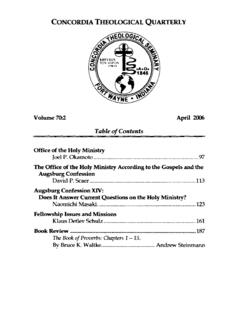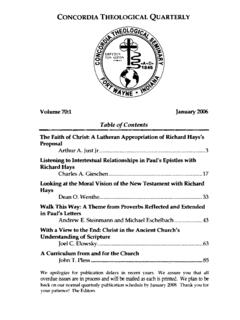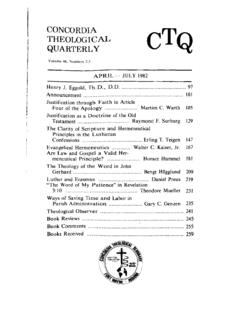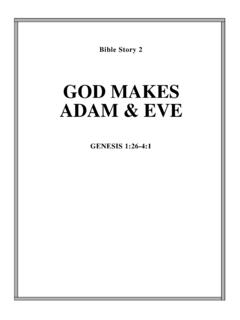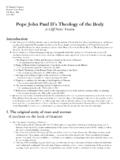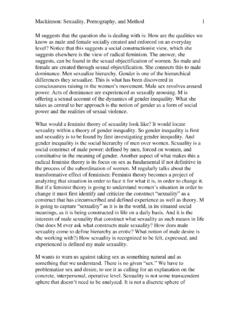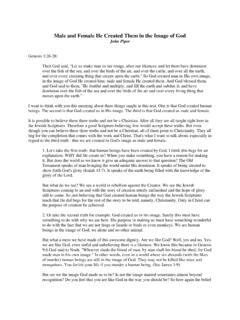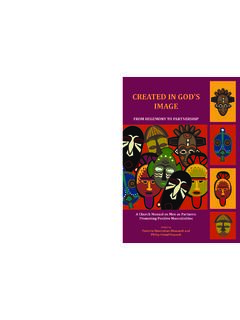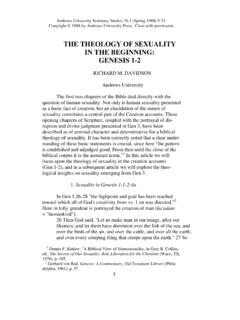Transcription of Man as Male and Female: Created in the Image of God
1 Volume 68:l January 2004 Table of Contents Introduction to "Man as Male and female " .. 3 William C . Weinrich Man as Male and female : Created in the Image of God . Nathan Jastram .. 5 INTRODUCIlON .. 5 L THE DEmNITION OF THE Image OF GOD .. 7 A. Various definitions of the Image of God .. 8 .. 1 General 8 . 2 Luther .. 12 .. 3 The Lutheran Confessions 15 .. 4 Synodical statements. resolutions. and teachinm 17 B . Biblical usage .. 18 .. 1 Kev biblical passages 18 .. a) Man in the Image or likeness of God 18 .. (1) Genesis 1:26-28 19 .. (2) Genesis 5:13 25 .. (3) Genesis 9% 27 (4) James 3:9 .. 28 (5) 1 Corinthians 11:7 .. 29 (6) Two reIated passages .. 38 i . Ephesians 42-24 ii . Colossians 39-10 .. b) %st as the Image or likeness of God 39 .. C) Man as the Image or likeness of Christ 40 d) Christ in the likeness ofman .. 41 2 . The meaning of "imapre" and "likeness".
2 41 . C . The Image of God is to be like God .. 46 1 . Support for this definition .. 46 a) "Likeness of God" as an aid to understanding " Image of God" .. 46 b) "Likeness of God" means "to be like God" .. 49 C) People who are like God can be called "gods" .. 52 2 . Usefulness of this definition for various questions .. 55 a) Inadequacy ofprevious defznitions .. 55 b) Resolving apparent contradictions .. 56 c) Applicability to wide range of topics .. 58 I1 . UNITY, DISTINCTION, & ORDERED RELATIONSHIPS IN GOD .. 60 A . Three persons in one God .. 60 B . Two nahues in one Christ .. 61 111 . UNITY, DISTINCIION, & ORDERED RELATIONSHIPS IN MAN .. 63 A . The unity of man and woman as the Image of God .. 63 B . The distinction between man and woman as the Image of God .. 64 1 . Biblical authoritv .. 64 2 . Biblical linkage of the irnape of God and the distinction between the sexes.
3 66 a) Genesis 1:27 6 5:l-2 .. 66 b) 1 Corinthians11:7 .. 67 c) Genesis 9:6 6 lames 3:9 .. 68 d) Opera ad extra and opera ad intra, so to speak .. 69 C . Living as the Image of God, also in ordered relationships .. 70 1 . Livin~ as the Image of God: vocation as "mask of God" .. 70 2 . Godlv order in the world .. 71 3 . Godlv order in societv at laree .. 74 - 4 . Godlv order in the familv .. 76 a) Husband and wife .. 76 .. b) Parents and children 79 5 . Godlv order in the church .. 81 a) The pastoral office .. 82 (1) Authority .. 82 (2) Representing Christ and participating in His work . 82 (3) Necessary qualifications .. 83 (4) Opera ad extra and opera ad intra, so to speak .. 84 b) Voting in the church .. 88 (1) An unchanging principle .. 88 (2) A changed application .. 89 c) Current controversies .. 90 d) Conclusion .. 94 CONCLUSION .. 95 Man as Male and female : Created in the Image of God Nathan Jastram The relationship between man and woman was intended as a source of great joy from the beginning.
4 ' It is difficult to imagine any topic that is more intimately connected with the lives of individuals from all stations of life in all parts of the world, unless it would be the topic of the nature of God. As it happens, those two topics are related. As controversies about sexual distinctions exercise society and church, it has become increasingly clear that the way in which one understands the relationship between man and woman is often linked to the way in which one understands the nature of God. This link finds its first expression in the account of creation itself: "So God Created man in his own Image , in the Image of God he Created him; male and female he Created them" (Gen. 1:27).~ Since man as male and female was Created in the Image of God, learning about God is linked to learning about man as male and female , and vice versa. In broad terms, the goals of this document are (1) to define the " Image of God" in a way that is faithful both to the biblical texts in which it occurs and to the wealth of scholarship devoted to the topic; (2) to examine whether the biblical passages that speak of the Image of God are related to the biblical passages that speak of sexual distinctions, and if so, in what way; (3) to explore whether the unity and distinction, the equality and order, that are included within God are also reflected in those who are Created in His Image ; and (4) to examine whether the ordered relation between the sexes depends on God's enduring design for His creation or on man's changing social customs.
5 This study often uses the word "man" and its corresponding masculine pronouns to refer to the human race as a whole, including both male and female , young and old. This usage is not intended to offend those who have chosen to avoid such language as a matter of policy in favor of "gender-neutral" language. Three reasons provide the rationale for such a 'I wish to thank those who have read earlier drafts of this paper and contributed their comments. Three in particular need to be mentioned by name, James Voelz, William Weinrich, and Harold Senkbeil, whose insightful questions and contributions have been incorporated throughout. Thanks are also due to Paul Nus, to Pilgrim Lutheran Church in West Bend, Wisconsin, and to the Lutheran Heritage Foundation for providing support to bring this project to completion. 2 Unless otherwise noted, the translation used in this study is the New International Version (Grand Rapids: Zondervan, 1973,1978,1984).
6 Usage in this document: (1) it is the way the Bible often speaks, particularly in the key passages under discussion; (2) it corresponds to the usage of a vast wealth of scholarship devoted to the Image of God; (3) it helps to teach the ordered unity of male and female that God intended when He Created them. It is true that in recent years so-called gender neutral Bibles have appeared, most notably the New Revised Standard ~ersion.~ Such translations are all seriously flawed in at least one respect-they deliberately change the text rather than translating the words that are there. Hebrew, Greek, and English are remarkably similar with respect to sharing the convention that the word "man" and masculine pronouns may be used to refer to human beings in general, both male and female . When translators deliberately change the text to make it "gender-neutral" instead of translating the text as it stands, they run the risk of making the Bible conform to the world rather than vice versa.
7 What begins as an attempt to be less offensive can lead to a serious corruption of the text that obscures teachings about Christ or about the relationship between the sexes. A warning note against embracing "gender-neutral" language was sounded by Leonard Klein years ago: One change may present more problems than some have thought, and that is the dropping of the term "man" for the human race. Not only does the term still merit consideration because it is widely used in a number of sciences and elsewhere as the name for the species, but in scientific theology as well it would seem to have a function that cannot be supplanted by the collective "people" or the abstractions "humankind and "humanity." Theolo~cally "man" means the adarnic whole, the rebellious one who stands over against God as his enemy. Martin Franzmann put it well: "In Adam we have all been one, one huge rebellious man" (LBW 372).
8 We have a solidarity in our sin and in our redemption by the second Adam that is watered down and obfuscated by more collective or abstract terms. Thus it is arguable that theology must continue to have not a doctrine of humanity but a doctrine of man, however we may choose to talk about the race in liturgy and The Commission on Theology and Church Relations (CTCR) of the Lutheran Church- Missouri Synod has written that the way the Bible uses the word "man" [Hebrew adam] is sigruficant for theology: "There are 3~he following comments are similar to comments we have made to The Commission on Worship of The Lutheran Church-Missouri Synod, which comments have now been included in its "Comparative Study of Bible Translations" (St. Louis: The Lutheran Church - Missouri Synod, 2002), 12. 4 Leonard Klein, "That God Is To Be Spoken of as 'He,"' Lutheran Fomnr Pentecost 1988), 23.
9 Man as Male and female : Created in the Image of God 7 several factors in the creation account in Genesis 2 which provide the basis for Paul's teaching about the relationship of man and woman.. The man is designated as Adam (v. 20), which is also the term used to describe the race. That the man is given this name suggests that he occupies the position as head of the relationship."' As head of the relationship, man represents the human race in a way that woman does not. It was through Adam that original sin infected the human race, even though Eve was the first to sin. And it was through another man, Jesus Christ, that the human race was cleansed from its sin: "For as in Adam all die, so in Christ all will be made alive" (1 Cor. 1522). It was not an accident that Jesus was man; it was necessary for him to be man in order to represent the entire human race.
10 When speaking theologically, then, it is best to be very cautious when replacing "man" with some other "gender-neutral" term, so as not to risk creating a new theology by altering how to refer to the human race. There is no such thing as humanity that is not enfleshed, engendered, as male or female , yet the Bible shows that it is not necessary to constantly distinguish the two sexes. They can both be called "man" as a result of the ordered unity in which God Created them, just as husband and wife can be called "one flesh." In this study, "man" refers specifically to the adult male only when it is used in connection with, or in contrast to, "woman," or when it refers to a particular male such as Jesus Christ. The plural "men" is used in this study to refer to adult males, but when the plural is found in quotations from biblical or other sources the context must determine whether it is used generally about all people or specifically about adult males alone.

